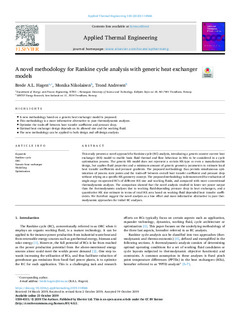| dc.contributor.author | Hagen, Brede | |
| dc.contributor.author | Nikolaisen, Monika | |
| dc.contributor.author | Andresen, Trond | |
| dc.date.accessioned | 2019-11-07T09:05:49Z | |
| dc.date.available | 2019-11-07T09:05:49Z | |
| dc.date.created | 2019-10-28T08:45:08Z | |
| dc.date.issued | 2019 | |
| dc.identifier.citation | Applied Thermal Engineering. 2019, 165 . | nb_NO |
| dc.identifier.issn | 1359-4311 | |
| dc.identifier.uri | http://hdl.handle.net/11250/2627105 | |
| dc.description.abstract | This study presents a novel approach for Rankine cycle (RC) analysis, introducing a generic counter current heat exchanger (HX) model to enable basic fluid thermal and flow behaviour in HXs to be considered in a cycle optimisation process. The generic HX model does not represent a certain HX-type or even a manufacturable design, but applies fluid properties and a minimum amount of generic geometry parameters to estimate local heat transfer coefficients and pressure gradients. The proposed methodology thus permits simultaneous optimization of process state points and the trade-off between overall heat transfer coefficient and pressure drop without relying on a specific HX-geometry concept. The proposed methodology is demonstrated for evaluation of single-stage recuperated RC's of different HX size and working fluids, and compared with more conventional thermodynamic analyses. The comparison showed that the novel analysis resulted in lower net power output than the thermodynamic analyses due to working fluid-depending pressure drop in heat exchangers, and a quantitative HX size estimate in terms of total HX area based on working-fluid depended heat transfer coefficients. We therefore suggest the novel analysis as a low effort and more informative alternative to pure thermodynamic approaches for initial RC analyses. | nb_NO |
| dc.language.iso | eng | nb_NO |
| dc.publisher | Elsevier | nb_NO |
| dc.rights | Navngivelse 4.0 Internasjonal | * |
| dc.rights.uri | http://creativecommons.org/licenses/by/4.0/deed.no | * |
| dc.title | A novel methodology for Rankine cycle analysis with generic heat exchanger models | nb_NO |
| dc.type | Journal article | nb_NO |
| dc.type | Peer reviewed | nb_NO |
| dc.description.version | publishedVersion | nb_NO |
| dc.source.pagenumber | 11 | nb_NO |
| dc.source.volume | 165 | nb_NO |
| dc.source.journal | Applied Thermal Engineering | nb_NO |
| dc.identifier.doi | 10.1016/j.applthermaleng.2019.114566 | |
| dc.identifier.cristin | 1740999 | |
| dc.relation.project | Norges forskningsråd: 255016 | nb_NO |
| dc.description.localcode | © 2019 The Authors. Published by Elsevier Ltd. This is an open access article under the CC BY license (http://creativecommons.org/licenses/BY/4.0/). | nb_NO |
| cristin.unitcode | 194,64,25,0 | |
| cristin.unitname | Institutt for energi- og prosessteknikk | |
| cristin.ispublished | true | |
| cristin.fulltext | original | |
| cristin.qualitycode | 1 | |

